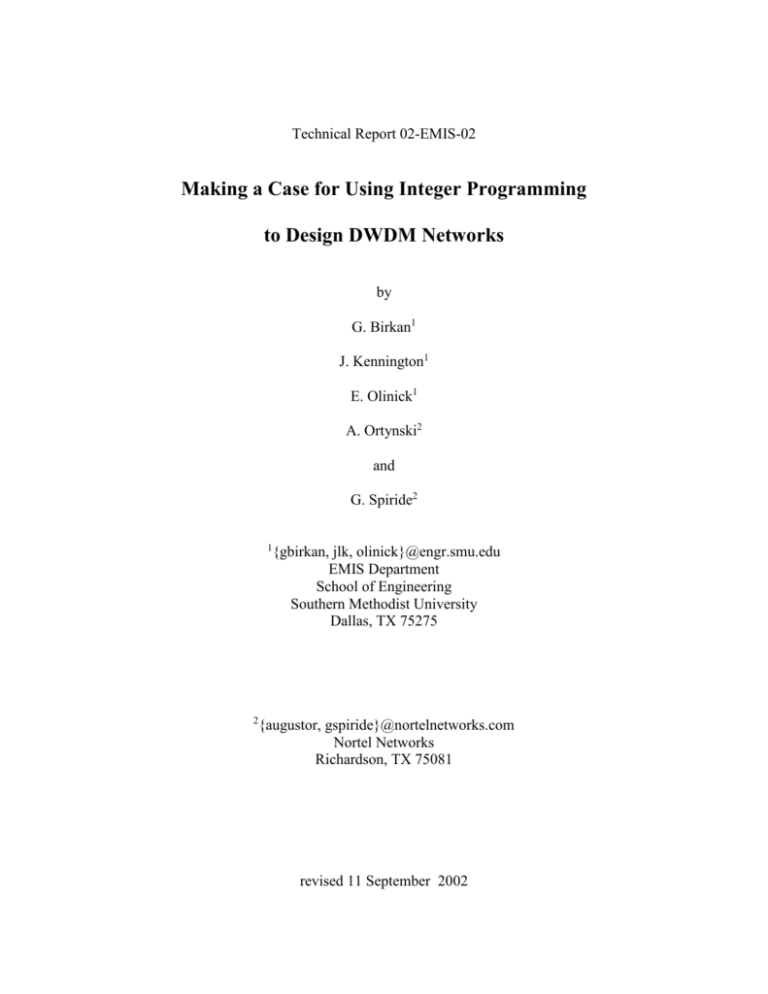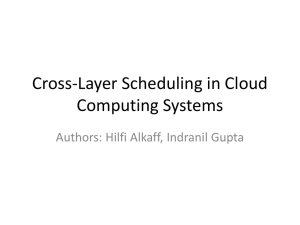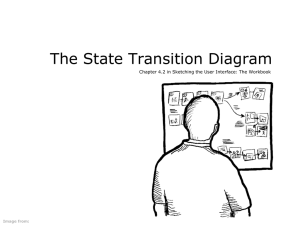4.1 Dedicated Protection - Lyle School of Engineering
advertisement

Technical Report 02-EMIS-02
Making a Case for Using Integer Programming
to Design DWDM Networks
by
G. Birkan1
J. Kennington1
E. Olinick1
A. Ortynski2
and
G. Spiride2
1
2
{gbirkan, jlk, olinick}@engr.smu.edu
EMIS Department
School of Engineering
Southern Methodist University
Dallas, TX 75275
{augustor, gspiride}@nortelnetworks.com
Nortel Networks
Richardson, TX 75081
revised 11 September 2002
Abstract
A variety of integer programming models are developed for several versions of the
DWDM routing and provisioning problem. The various versions differ in the type of
protection implemented and whether the point-to-point demand matrix is known with
certainty. Protection is provided for single link failures using one of the following
strategies: dedicated protection, p-cycle protection, or shared protection. Demand
uncertainty is modeled using a two-phase robust optimization strategy. We introduce a
new set of models that combine both single link protection and demand uncertainty for
the DWDM design problem. To the best of our knowledge, optimization models
combining both of these features have not appeared in the literature. This investigation
presents a strong case for using integer programming models and solution software to
help design DWDM networks.
Acknowledgement
This investigation was partially supported by grants from Nortel Networks and the Office
of Naval Research under Award Number N00014-96-1-0315.
Keywords:
integer programming applications, robust optimization, network
provisioning, fault-tolerant network design
1. Introduction
Recent advances in point-to-point dense wavelength division multiplexing (DWDM)
transmission systems have led to enormous increases in optical network link capacity.
Mas and Thiran (2001) describe a system that groups 432 fibers on a single ribbon. Each
fiber can multiplex up to 164 wavelengths each operating at the rate of 10 Gbps. Due to
the complexity of these high-speed systems and the enormous number of possibilities to
be considered, equipment manufacturers and service providers need specialized
computational tools to help automate the preparation of network designs.
Computational tools for these design problems can use either descriptive models or
prescriptive models. Descriptive models may be used to evaluate fixed decision
alternatives rather than indicating good design choices. Computer simulation, used with
descriptive models, can be very detailed in their description of the system. Commercial
products based upon simulation are available from OPNET Technologies, Inc., RSoft,
Inc., VPI Systems, and ARTIS Software Corporation. A simulation-based tool developed
in academia is described in Wen et al. (2001).
The literature is replete with prescriptive integer programming models for various
versions of DWDM design problems. Industry has been slow to adopt optimizationbased models and solution software. Some tools use a shortest path method for routing
and graph coloring heuristics for wavelength assignment, but few make use of integer
programming which can address both issues simultaneously. Proprietary heuristics are
popular and some systems may have a simulated annealing module (see Boggio et al.
2001). Many academic studies that produce integer programming models indicate that
problems based upon their models are computationally solvable only for small problem
1
instances. In our investigation, we present new specialized integer programming models
that incorporate important design issues (namely, uncertainty in demand forecasts and
network protection) and provide empirical evidence that our models are indeed
computationally solvable for moderate sized networks. Unlike the heuristic procedures
of others, our solutions come with a guarantee that they are within a pre-specified β% of
optimality. We call β the optimality gap and generally use 5% in our computational
testing.
The basic DWDM design problem may be defined as follows: Given a network
topology and a forecast of the point-to-point demand traffic, determine the routing for
each point-to-point demand and the least cost DWDM equipment configuration required
to support these routes. The equipment operating characteristics, equipment cost, and
forecasts for services determines the design of a DWDM network. Over time equipment
capabilities tend to increase and equipment costs decrease. However, these changes can
easily be included in the models. There are two additional issues that are of interest to
both the equipment manufactures and service providers. The first is the protection
scheme needed to protect the working traffic against node and/or link failures, and the
second is the uncertainty of the demand forecasts. This investigation presents integer
programming models for the most popular protection schemes. Problem instances using
these models are solved and cost comparisons are made. Using the robust optimization
concept developed in Kennington et al. (2001), these models are extended to include both
demand uncertainty and protection.
2
1.1 Survey of Literature
Excellent discussions on optical layer survivability issues may be found in Ramaswami
and Sivarajan (1998) and Gerstel and Ramaswami (2000a, 2000b). Focus is placed on
explaining the rationale for protection at this layer as well as classifying the different
types of failures and protection schemes. A discussion of protection in WDM mesh
networks along with an on-line control mechanism may be found in Zang and Mukherjee
(2001). While failures can occur in links, nodes, and/or individual channels (in the case
of WDM networks), our investigation addresses the issue of link failures. Such failures
occur due to fiber cuts or line equipment failures. In almost all cases, protection
mechanisms are designed to protect against a single link failure. That is, there is an
assumption that simultaneous multiple failures are very rare.
Protection strategies are designed for either a ring topology or a mesh topology. A
ring is the simplest topology that is two-connected and much of the carrier infrastructure
uses SONET/SDH rings. Since there are exactly two link-disjoint paths linking every
pair of nodes on a ring structure, then switching to the backup path can be easily
accomplished. The disadvantage is that such networks can be quite expensive compared
to mesh designs. For a mesh design, carriers can use either link restoration or path
restoration. The former provides a backup path around each link while the latter restores
point-to-point traffic from the origin to the destination of an (o,d) demand pair (see
Ramaswami and Sivarajan 1998). Link restoration is simpler to implement but requires
more resources than path restoration. Each of these strategies can use either dedicated
protection paths or shared protection paths, with dedicated paths being the most
expensive. Grover and Stamatelakis (1998) and Stamatelakis and Grover (2000a, 2000b)
3
present innovative ideas based upon the concept known as p-cycles that attempt to obtain
the speed benefits of rings as well as the capacity benefits of mesh architectures. The
foundations for these new ideas were laid by Chujo et al. (1991), Grover et al. (1991),
Herzberg (1993), Herzberg and Bye (1994), Iraschko et al. (1998), and Murakami and
Kim (1998). Joint planning models can be found in Saito et al. (1998) and in Lewis
(2002), and a specialized branch-and-bound algorithm to solve such models may be
found in Kennington and Lewis (2001). All of these studies attempt to solve the static
design case and use spare capacity as the decision variables. The specific equipment
needed to acquire this capacity is not presented and an assumption is made that
equipment can be installed to achieve the capacity requirements. In addition,
minimization of capacity is used as a surrogate for minimizing equipment cost. Our work
differs from previous investigations in that our models use node and link architecture
assumptions to meet the spare and working capacity requirements; and therefore, cost is
directly related to equipment required.
1.2 Contributions
Our contributions are primarily in the area of mathematical modeling of difficult
design problems that incorporate either path restoration and/or demand uncertainty. First,
we developed optimization-based models to generate the k-shortest node-disjoint cycles
in a graph. Using input from our industry colleagues, our cycles cannot contain a pair of
arcs that cross as illustrated in Figure 1. Some of the clients for this work view such
cycles as unacceptable. Second, we developed new optimization-based models for the
DWDM design problem using the most popular protection schemes (dedicated
protection, p-cycle protection, and shared protection). Two key tuning parameters for
4
problem solution are the number of candidate cycles input and the optimality gap
permitted. Our third contribution is an empirical study that leads to recommendations
concerning these tuning parameters. Our fourth contribution is a set of new optimizationbased models for the DWDM design problem that incorporates both network protection
and demand uncertainty. To our knowledge, this is the first time that both of these issues
have been addressed in a single set of optimization models. In addition, we present
empirical evidence that our proposed models are computationally solvable. Finally, we
make our models available on the world wide web for downloading for immediate use by
industrial design groups who need to address this type of problem. Such design groups
that have access to AMPL (Fourer et al. 1993) and CPLEX (www.cplex.com) only need
supply their specific data to have a working design tool. Other research groups also have
complete access to both our models and test data for independent verification and
comparison with their design systems. All models and test data can be found at
www.engr.smu.edu/~jlk/01-EMIS-07/main.htm. In the remainder of this manuscript, this
URL is referred to as the study web site.
-----------------------------------------Figure 1 About Here
------------------------------------------
2. Cycle Generation
All of the protection models developed in this investigation use a set of cycles for each
(o,d) demand pair as input. A cycle for demand (o,d) is composed of a pair of node
disjoint paths from o to d. One path is called the working path and the second is
designated as the protection path. Each cycle for an (o,d) pair is obtained by solving two
binary linear programs, one for the working path and one for the protection path.
5
Consider the sample network illustrated in Figure 2. The sets used to define the
network, the working paths, and the protection paths are given in Table 1. Working path
1 connects nodes 1 and 7 using links 2 and 11, while the corresponding protection path
connects these nodes using links 1 and 9. Note that these two paths are node disjoint and
form a cycle that resembles an oval.
-----------------------------------------Figure 2 & Table 1 About Here
-----------------------------------------The working path model produces the shortest path in units of km from origin o to
destination d subject to three restrictions. Node o (d) is designated as a supply (demand)
node with a supply (demand) of 1. Hence, one unit of flow (corresponding to a path) will
travel from node o, through the network, and terminate at node d. This is modeled using
a flow conservation constraint for each node. The second restriction forbids flow in a
pair of arcs that cross one another. This ensures that pictorially all cycles appear as ovals.
The third restriction ensures that the paths are distinct. A new path cannot use the same
links as any previously generated working or protection path. In addition to being
distinct, this means that none of the paths generated will contain repeated nodes.
The protection path model also seeks a shortest path from o to d and is
implemented with four types of constraints. The first is flow conservation at all nodes.
Constraints of the second type require that the protection path be link disjoint from the
new working path. The third restriction is that the protection path be node disjoint from
the new working path at all nodes except o and d. Finally, the protection path can have
no crossing links with either the new working path or itself.
6
These models use sets N, E, and D as input and produce sets P, Lw, Lp, and J as
output. The detailed models in AMPL format can be found in Appendix A and at the
study web site.
3. Basic Design Model Without Protection
The basic design model is defined in the companion paper (Kennington et al. 2001) and is
only briefly described in this section. The main components of the network are fiber,
terminal equipment (TEs) placed at the nodes, optical amplifiers (As), and regenerators
(Rs). In this investigation, wavelength transponders that perform the optical-electricaloptical conversion at the nodes are referred to as TEs. We assume that dark fiber is
available at no additional cost and that As, Rs, and TEs can be installed to make the fiber
operational.
A pair of integer programs has been developed to solve the DWDM routing and
provisioning problem. The arc-path model uses a set of candidate paths for each (o,d)
demand pair from which an optimal set is selected. Since not all possible paths are
considered for a problem instance, this produces a feasible upper bound for the true
problem that includes all paths as part of the input. A node-arc model has all paths
implicitly available and hence produces a true lower bound for this problem. The
disadvantage of the node-arc model is that routing may be circuitous and require an
unacceptably large hop count. The arc-path model provides complete control over the
potential paths and avoids the aforementioned disadvantages. When used in conjunction,
one obtains an acceptable routing and valid upper and lower bounds.
The node-arc model is to minimize equipment cost and includes seven types of
constraints. |N||D| flow conservation constraints ensure that the demands are satisfied.
7
The other six types of constraints require one constraint per link. Hence, there are
|N||D|+6|E| constraints in the node-arc model. Type 2 constraints accumulate the flows
for the various (o,d) pairs into total flows on each link. Given link flows, the total
number of fibers, channels, TEs, As, and Rs can be determined. The arc-path model is
quite similar except that path flows must be converted to link flows. If xp denotes the
flow on path p and ze denotes the flow on link e, then the conversion is accomplished by
the following |E| equations:
eE
xp = ze
pLwe
The main outputs from both models are the number of TEs, As, and Rs. Given cost
values for equipment of this type, minimum cost solutions can be determined. Both
models have been implemented in AMPL and the run file can be found in Appendix B
and at the study web site.
4. Protection Models With Known Demands
In this section we present three different schemes for protection against single link
failures when the demands are known with certainty. Each scheme has pros and cons
related to ease of implementation versus total spare capacity required. In general, a
design with less equipment requires a more complex restoration procedure (Gerstel and
Ramaswami 2000a, 2000b).
4.1 Dedicated Protection
The simplest idea for protecting the links in a path for an (o,d) demand pair is to
provision a node disjoint path from o to d with capacity equal to the traffic demand. If
any link in the working path fails, then traffic is simply switched to the protection path.
8
We have developed two models for designing a network that uses dedicated protection, a
node-arc model and an arc-path model. For the node-arc model we simply double the
traffic requirement for each (o,d) pair and place an upper bound equal to the traffic value
on each arc. This forces the traffic from o to d for each demand pair to use at least two
different paths. Of course, the flow could be split among more paths to make use of
terminal equipment, amplifiers, and/or regenerators being used by other (o,d) pairs. In
any case, this yields a true lower bound for this problem. The arc-path model has a set of
candidate cycles for each (o,d) pair as input from which an optimal selection is made.
For both models, the link flow can be converted to equipment requirements, TEs, As, and,
Rs. For our test cases, each fiber can accommodate 80 channels or s. In the arc-path
model, we require that working and protection traffic be allocated to unique channels.
Suppose each wavelength can accommodate 192 DS3s and a certain link has an
allocation of 96 DS3s of working traffic and 96 DS3s of protection capacity. The model
requires that the design use two different s (channels) for this traffic, which requires two
regenerators rather than one.
The AMPL run file for dedicated protection can be found in Appendix C and at
the study web site. This file contains the following four models: a working path
generator model, a protection path generator, a node-arc dedicated protection model, and
an arc-path dedicated protection model. The first two models generate input for the
protection models.
4.2 P-Cycle Protection
P-cycle protection requires that every link that carries working traffic have both incident
nodes in a spare capacity cycle called a p-cycle. If the corresponding link is part of the p-
9
cycle, then the p-cycle must have sufficient capacity to protect this working link. If the
corresponding link is not in the p-cycle, but has both incident nodes in the p-cycle, then
the spare capacity cycle must have capacity at least 50% that of the working traffic. That
is, if link (i,j) fails, then there are two paths connecting i and j in the spare capacity cycle.
Hence, 50% of the working traffic can be routed around the ring (p-cycle) in the
clockwise direction and 50% can be routed in a counter-clockwise direction. Links that
cut across a p-cycle are called chord-links.
The specific constraints used in p-cycle protection are discussed below. Let xp
denote the amount of working traffic assigned to working path p and let rod denote the
total demand for the pair (o,d). Then the demand constraints are as follows:
(o,d) D
xp = rod
pJ od
Since flows are in terms of paths and equipment is provisioned on links, |E| constraints
are used to convert from path flows on the working path to link flows as follows:
eE
xp = ze
pLwe
Since working traffic and protection capacity must be allocated distinct wavelengths, the
working traffic is rounded up to the next wavelength. Let M denote the number of DS3s
multiplexed on a single wavelength and ye be a nonnegative integer variable. Rounding
up is accomplished by the following |E| constraints:
eE
ze < Mye
For p-cycle protection, spare capacity must be allocated to cycles defined by J,
Lw, and Lp. Let cp denote the spare capacity assigned to cycle p and se denote the total
spare capacity assigned to link e. Then
10
pLwe
Lpe
eE
cp = se
Some working traffic will be allocated to links in p-cycles for some (o,d) pairs and others
will be allocated to chord-links in the candidate cycles. Let Ce denote the set of p-cycles
for which link e is a chord-link. For both cases the spare capacity must be sufficient to
protect the working traffic. The following |E| constraints ensure that this is the case.
pLwe
cp + 2
Lp e
cp > ze
pC e
eE
Finally, provisioning of TEs ,As, and Rs, requires that sufficient equipment be provided to
accommodate both the working traffic and the spare capacity. That is, equipment is
determined from ue where
eE
ue = Mye + se
Conversion of ue into TEs, As, and Rs is described in Kennington et al. (2001). Note that
this is a joint model in that both the assignment of working traffic to paths and protection
capacity to cycles are determined in a single model. This can provide an economic
advantage over solutions provided by separate models for working traffic and protection
capacity. The AMPL run file for p-cycle protection can be found in Appendix D and at
the study web site.
4.3 Shared Protection
Path restoration using shared protection is the most difficult model to construct. This
occurs because a link failure can disrupt working traffic on several (o,d) pairs all of
which require new restoration paths. Our shared protection model requires a fixed
routing of the working traffic. Let pF denote the set of links whose failure disrupts
working traffic for some (o,d) pair. For each f pF, pDf denotes the set of (o,d) pairs
11
affected by the failure of link f. Since the traffic for a demand pair, rod, can be split
among multiple paths, qfod denotes the total amount of traffic from o to d that must be
restored when f fails. Since the working traffic and the spare capacity (also called the
protection traffic in this model) must use unique s, we let we denote the working traffic
on link e rounded up to the smallest number of s that is at least as great as the working
traffic.
We now define three new decision variables. Let tpf denote the protection traffic
on path p when link f fails. Let ve denote the total protection traffic on link e and ge
denote the total traffic (working plus protection) on link e. Using this notation, the
shared protection model uses three sets of constraints to determine the values for ge. The
demand for spare capacity is defined by the following constraints:
pJ od \ Lp f
tpf
f pF, (o,d) pDf
= qfod
Note that a protection path containing link f cannot be used to protect against failures of
link f. Conversion of protection path flows to link spare capacity requirements is
accomplished by the following inequalities
e E, f pF
tpf < ve
pLp e
That is, the spare capacity must be sufficient to accommodate the failure that produces
the largest traffic disruption. Provisioning of equipment on a link is determined by the
working traffic on the link plus the spare capacity on the link. The following |E|
equations provide this value
eE
ge = we + ve
12
Conversion of ge into TEs, As, and Rs is as before.
The AMPL run file for shared protection can be found in Appendix E and at the
study web site. Note that this run file contains the design model without protection
followed by the shared protection model. Hence, unlike the p-cycle model, it cannot
rearrange the working traffic to reduce the cost of protection. It is possible to construct a
joint shared protection model as demonstrated by Lewis (2002). However, a joint model
would be substantially larger and more difficult to solve. For networks whose average
degree is low (around 2.5), Lewis found very little improvement from the use of a joint
model.
4.4 Empirical Analysis
Two network topologies as illustrated in Figures 3 and 4 are used in our empirical
analysis. Each test case has five scenarios for point-to-point demands yielding a total of
ten test cases. The DA problem is a US network and was provided to us by Dr. J. D.
Allen (2001) and the KL problem is a European network described in Van Caenegem et
al. (1998). Two (one) hundred point-to-point demands for each of the scenarios were
randomly generated for the DA (KL) problem using a population based traffic generator
as described in Chapter 4 of Cahn (1998). The data files for the test problems may be
found at the study web site.
-----------------------------------------Figures 3 & 4 About Here
-----------------------------------------All test runs for the ten problems were made on a Compaq AlphaServer DS20E
with dual EV 6.7 (21264A) 667 MHz processors and 4096 MB of RAM. Solution
statistics for the five DA problems may be found in Table 2. We used a 30-minute time
13
limit on all test runs and 15 of these runs terminated due to the time limit. All arc-path
models used the ten shortest paths. For both the no protection and dedicated protection
runs, node-arc models provide lower bounds and arc-path models provide upper bounds.
The no protection runs all yielded solutions guaranteed to be within 0.3% of optimality
while the dedicated protection runs all yielded solutions with a 1.4% guarantee. In all
cases, the arc-path model used the full 30 minute time limit. Note that the cost for
dedicated protection is 155% more than the cost for the designs without protection. This
occurs because the least cost paths have already been selected to accommodate the
working traffic and consequently the spare capacity must use more expensive paths.
However, p-cycle protection only requires 94% additional cost and shared protection was
73% more expensive. This clearly illustrates the cost advantage of both p-cycle and
shared protection over dedicated protection.
-----------------------------------------Table 2 About Here
-----------------------------------------One of the tuning parameters for CPLEX is the optimality gap. That is, using an
optimality gap of 5% permits termination as soon as a solution is obtained that is
guaranteed to be within 5% of the optimum. When 5% optimality gaps were used,
solution times on most of the problem instances dropped from 30 minutes to only a few
seconds as illustrated in Table 3. This resulted in a small increase in the guaranteed
deviation from optimality, but we believe that most users will prefer the reduced run
times. The reported times were rounded up to the nearest second and in many cases the
time was reduced by a factor exceeding 1800.
14
-----------------------------------------Table 3 About Here
-----------------------------------------For arc-path models, there is the additional issue of how many paths per (o,d)
demand pair should be used in the model. For our runs, 10 paths per demand were used.
To help demonstrate that 10 paths is sufficient, the no protection and dedicated protection
models were solved for the third scenario using 1, 2, …, 10 paths per demand. The
optimal costs for these 20 runs are given in Table 4. Note that very little cost
improvement occurred after the fifth path was used. Based on these results, we believe
that 10 paths per demand are more than sufficient for our arc-path models.
-----------------------------------------Table 4 About Here
-----------------------------------------Similar results were obtained for the KL problems as summarized in Table 5.
However, p-cycle protection was slightly less expensive than shared protection. In
theory, shared protection should never be more expensive than p-cycle protection. There
are two notions that could account for this anomaly. The p-cycle model is a joint model
that determines both working traffic and protection capacity simultaneously whereas the
shared model computes these sequentially. The KL problem has a higher node degree
that may favor the p-cycle paradigm.
-----------------------------------------Table 5 About Here
-----------------------------------------Based on our experimental results, we conclude that integer programming models
and solution procedures can be successfully used to solve moderate sized DWDM routing
and provisioning problems. To our knowledge, all commercial design software use
15
heuristics and provide no solution quality guarantee. We found that 10 shortest paths per
demand is more than sufficient for use with the arc-path models. However, the value of
10 is a single parameter in the AMPL run files and can easily be modified if a user
prefers a different value. We recommend setting the optimality gap parameter to 5% to
reduce the computational effort needed to solve these models. Integer programming
algorithms can generally find a good solution fairly quickly, but may require a substantial
effort to prove optimality. Setting this single tuning parameter to 5% resulted in
eliminating these long run times needed to prove optimality. While shared protection
theoretically provides the least cost design, we found that p-cycle protection is very
competitive to shared protection and is substantially less expensive than dedicated
protection.
5. Basic Design Model for Unknown Demands
We model the unknown demands using a discrete probability distribution with sample
space S = {1,…,ŝ}. Each s S is called a scenario and has the probability Prs. The
elements of the traffic demand matrix for scenario s are denoted by rods for all (o,d) D.
From the literature (Mulvey et al. 1995, Kennington et al. 2001) the idea of a robust
design is one that works reasonably well over a range of scenarios. The notion of
reasonably well is modeled by a regret function.
Consider the network illustrated in Figure 2 with demand scenarios given in Table
6. Suppose there is a single demand, (1,7), and the working path for this demand uses
links (1,4) and (4,7). Suppose the network has been provisioned to accommodate 576
DS3s (i.e. 3 wavelengths at 192 DS3s per wavelength). Clearly, this design is over
provisioned for the first two scenarios and is under provisioned for the third. A quadratic
16
regret function as computed in Table 6 is used to capture the idea of robustness. The
basic strategy is to create a design such that the total regret taken over all demand pairs is
as small as possible.
-----------------------------------------Table 6 About Here
-----------------------------------------Since quadratic integer programs can be quite difficult to solve, we use a fourpiece linear approximation for each side (over provisioning and under provisioning) of
the regret function. Hence, our robust optimization model is a linear integer program.
m
p
Let z odsk
(z odsk
) denote the amount of over (under) provisioning for demand pair (o,d),
scenario s, and linear piece k. Let s mk (s kp ) denote the slope for over (under) provisioning
for linear piece k. Then the regret is simply
R=
Prs
( o , d )D , sS
k 1,..., 4
m
p
(s mk z odsk
+ s kp z odsk
)
Let TEe, Ae, and Re denote the number of TEs, As, and Rs needed on link e, with
corresponding unit costs of CTE, CA, CR. Then the total equipment cost is
Q=
(CTETEe + CAAe + CRRe)
eE
If the capital expenditure budget is B, then
Q<B
enforces a budget restriction.
Our robust design scheme actually uses a two-phase procedure. In the first phase,
the objective is to minimize regret subject to the budget constraint. Suppose the optimal
regret is Ropt. In the second phase, regret is fixed at Ropt and the objective is to minimize
Q (the equipment cost). This two-phase approach yields a minimum regret design that is
17
also efficient with respect to expenditures for equipment. That is, no other design can
achieve this regret value with lower cost, and any lower cost design must have higher
regret.
Our AMPL model implementing the two-phase robust optimization procedure can
be found in Appendix F and at the study web site. We again use 10 cycles per demand.
This implementation uses a nonsymmetrical regret function with under provisioning
having a larger penalty than over provisioning.
6. Robust Design Models With Protection
The two-phase robust optimization scheme has been extended to permit dedicated
protection, p-cycle protection, and shared protection. Both dedicated protection and pcycle protection are joint models that determine routes for both working traffic and
protection traffic in a single model. The shared protection model provides protection
based on the routing from the basic design model defined in Section 5 and Appendix F.
All protection models are extensions of the ideas presented in Section 3. All AMPL run
files are available in Appendices G, H, and I and can be found on the study web page.
The DA problem with the five demand scenarios and three budget values have
been run with all four robust design models, and the computational results are
summarized in Table 7. The no protection model ran in approximately 10 seconds and
routed most of the demand for all scenarios. The budget constraint was not binding for
any of the three budgets. The percentage of unrouted demand is given by
(
100
( o ,d )D , sS ,k 1,..., 4
p
z odsk
)/(
( o ,d )D , sS
18
)
rods
The dedicated protection runs required between 16 and 18 seconds. The budget
constraint was binding for all three runs and as the budget was tightened, both the regret
value and the demand not routed increased. The p-cycle protection runs required
approximately one minute, but provided improvements in both equipment cost and/or
routed demand as compared to dedicated protection. The best results were achieved
using the shared protection model, which required approximately 20 minutes for the tight
budget. Also note that for the moderate and tight budgets, most of the budget was spent
on routing the working traffic leaving little money available for the spare capacity model.
This is preferable to the p-cycle protection models that provide higher protection at the
expense of higher unrouted demand. The minor variations in unrouted demand for the no
protection case and the shared protection case are a result of the procedures used to
obtain the input for the two cases. The no protection model uses 10 shortest paths per
demand for the arc-path formulation. The shared protection model uses the 10 shortest
cycles per demand composed of a working path and a protection path. Hence, the
working paths are slightly different for the two cases even though the no protection
models are identical. Similar results were obtained on the KL problem, which are
summarized in Table 8.
-----------------------------------------Tables 7 & 8 About Here
-----------------------------------------These results demonstrate that integer programming modeling languages and
solution software have been developed to the point that they can be used to solve difficult
DWDM design problems. The models in this section capture both demand uncertainty
19
via the use of a two-phase robust optimization procedure and single link protection.
These are the first models that include both of these important issues in a single model.
7. Summary and Conclusions
We believe that integer programming provides the best technology available to assist
DWDM network designers. A modeling language makes it quite easy to define a variety
of integer programming models and high performance optimizers can be employed to
obtain good solutions to problem instances. The optimality-gap parameter and the totaltime-to-solve parameters can be used to control the CPU time required to obtain a
solution. Designers have been reluctant to use integer programming because of its
reputation of having excessively long run times. These tuning parameters allow the users
to control the run times. Since an early exit provides both an upper and lower bound, the
designer has the information needed to determine if more computational effort is
warranted. We have illustrated how to incorporate both demand uncertainty using the
robust optimization approach and single link protection using a variety of architectures.
We found that p-cycle protection is fairly cost efficient compared to shared protection
and both are much less expensive than dedicated protection. Under tight budgets, cycle
based protection strategies, e.g. p-cycle and dedicated protection, exhibit the drawback of
excessive unrouted demand when compared to shared protection. All nine models are
available on the study web site and others are invited to experiment with these models.
References
Allen, D. 2001. Cinta Corp. Plano, TX. private communication.
Boggio, G., M. Burzio, N. Portinaro, J. Cai, I. Cerutti, A. Fumagalli, M. Tacca, L.
Valcarenghi, A. Carena, R. Gaudino. 2001. Network designer - Artifex™ OptSim™: a suite of integrated software tools for synthesis and analysis of high
speed networks. Optical Networks Magazine 2 27-41.
20
Bradsher, K. 1991. How an A.T. & T. accident snowballed. New York Times January.
Cahn, R. 1998. Wide Area Network Design: Concepts and Tools for Optimization.
Morgan Kaufmann Publishers, Inc. San Francisco, CA.
Chujo, T., H. Komine, K. Miyazaki, T. Ogura, T. Soejima. 1991. Distributed self-healing
network and its optimum spare-capacity assignment algorithm. Electronics and
Communication in Japan 74 1-9.
Fourer, R., D. Gay, B. Kernighan. 1993. AMPL A Modeling Language for Mathematical
Programming. Boyd & Fraser Publishing Company, Danvers, MA.
Gerstel, O., R. Ramaswami. 2000a. Optical layer survivability: a services perspective.
IEEE Communications Magazine 104-113.
Gerstel, O., R. Ramaswami. 2000b. Optical layer survivability: an implementation
perspective. IEEE Journal on Selected Areas in Communications 18 1885-1899.
Grover, W., T. Bilodeau, B. Venables. 1991. Near optimal synthesis of a mesh restorable
network. GLOBECOM 1991 2007-2112.
Grover, W., D. Stamatelakis. 1998. Cycle-oriented distributed preconfiguration: ring-like
speed with mesh-like capacity for self-planning network restoration. IEEE
International Conference on Communications 1998 1 537-543.
Herzberg, M. 1993. A decomposition approach to assign spare channels in self-healing
networks. GLOBECOM 1993 1601-1605.
Herzberg, M., S. Bye. 1994. An optimal spare capacity assignment model for survivable
networks with hop limits. GLOBECOM 1994 3 1601-1606.
Iraschko, R., M. MacGregor, W. Grover. 1998. Optimal capacity placement for path
restoration in STM or ATM mesh survivable networks. IEEE/ACM Transactions on
Networking 6 325-336.
Kennington, J., M. Lewis. 2001. The path restoration version of the spare capacity
allocation problem with modularity restrictions: models, algorithms, and an
empirical analysis. INFORMS Journal on Computing 13 181-190.
Kennington, J., K, Lewis, E. Olinick, A. Ortynski, G. Spiride. 2001. Robust solutions for
the WDM routing and provisioning problem: models and algorithms, Technical
Report 01-EMIS-03, EMIS Department, School of Engineering, SMU, Dallas, TX,
to appear in Optical Networks Magazine.
21
Lewis, M. 2002. Joint capacity allocation with modularity and stub release in mesh
telecommunication networks: an experimental design approach. Technical Report,
School of Business, University of Business, University of Mississippi, University,
Mississippi.
MacGregor, M., W. Grover. 1994. Optimized k-shortest paths algorithm for facility
restoration. Software-Practice and Experience 24 823-834.
Mas, C., P. Thiran. 2001. A review on fault location methods and their application to
optical networks. Optical Networks Magazine 2 73-87.
Mulvey, J., R. Vanderbei, S. Zenios. 1995. Robust optimization of large-scale systems.
Operations Research 43 264-281.
Murakami, K., H. Kim. 1998. Optimal capacity and flow assignment for self-healing
ATM networks based on line and end-to-end restoration. IEEE/ACM Transactions
on Networking 6 207-221.
Ramaswami, R., K. Sivarajan. 1998. Optical Networks: A Practical Perspective, Morgan
Kaufmann Publishers, Inc. San Francisco, CA.
Saito, H., Y. Miyao, T. Komine, F. Kubota. 1998. Joint capacity assignment to stateindependent working and spare paths for enhanced survivability. IEEE International
Conference on Communications 1998 3 1743-1748.
Stamatelakis, D., W. Grover. 2000a. IP layer restoration and network planning based on
virtual protection cycles. IEEE Journal on Selected Areas in Communications 18
1938-1949.
Stamatelakis, D., W. Grover. 2000b. Theoretical underpinnings for the efficiency of
restorable networks using preconfigured cycles (“p-cycles”). IEEE Transactions on
Communications 48 1262-1265.
Van Caenegem, B. W. Van Parys, F. De Turck, P. Demesster. 1998. Dimensioning of
survivable WDM networks. IEEE Journal on Selected Areas of Communications 16
1146-1157.
Wen, B., N. Bhide, R. Shenai, K. Sivalingam. 2001. Optical wavelength division
multiplexing (WDM) network simulator (OWns): architecture and performance
studies. Optical Networks Magazine 2 16-26.
Zang, H., B. Mukherjee. 2001. Connection management for survivable wavelengthrouted WDM mesh networks. Optical Networks Magazine 2 17-28.
22









